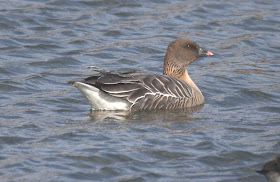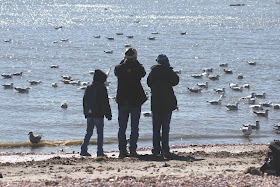A Nomad Goose so far from its home-yet so close to mine! Saturday morning I was in my studio putting the finishing carving touches on a drake
Wood Duck decoy. Jen told me that she just read on CTBirds that Mark Barriger had just reported a Pink-footed Goose at Lyman’s Orchard Pond. Since Lyman’s is only fifteen minutes from our house, I grabbed my camera and we were on our way. The pond at the Apple Barrel store in Middlefield has hosted some very special Geese the last two winters.
On November 25, 2010, a Greater White-fronted, and an immature Blue Goose were spotted in the pond. When I was there photographing those two Geese, I also spotted a single
Greater White-fronted Goose at Lyman’s Pond Immature Blue Goose at Lyman’s Pond Part of the flock of eighteen Blue Geese at nearby White’s Farm in Durham A bit of information about the visiting Pink-footed Goose (Anser brachyrhynchus)- This monotypic Goose breeds in eastern Greenland , Iceland and Svalbard (an archipelago in the Arctic, constituting the northernmost part of Norway
The geese migrate to winter in the countries surrounding the North Sea , (the entire world population winters in just a few European countries). There are two populations. The population that breeds in east Greenland and Iceland migrate and winter in Britain and Ireland Netherlands , Denmark and Belgium
For information regarding the two Pink-footed Geese noted in CT this winter, see Greg Hanisek’s blog: http://blogs.rep-am.com/nature/2012/02/26/how-many-pink-footed-geese-2/
My report to CTBirds: The P F Goose was swimming in the pond with approx. 75Geese Canada
It gave good close looks, and walked out of the pond exposing those obvious 'pink" feet and tarsus.
The P F Goose stretches its wings.The Goose was suddenly startled; it jumped up but landed again after a quick “hop” into the air.
This smaller Goose stood its ground against the larger
aggressive larger Canada Goose.
It walked up onto the lawn and started grazing with the Canadas Portraits of this beautiful nomadic GooseWhile I was there photographing this special Goose, there were several other birders
there. Russ Smiley introduced himself to me, and he then pointed out a hen Shoveler on the opposite shore of the pond.
The Shoveler was often mixed in with the Geese and ended up in many photos with the P F Goose
This Goose seems quite timid, and seems to prefer to stay on the periphery of all the other birds.
I couldn’t resist, I had to take a few shots of these Canada Geese…..
…..and this Mallard/Black Duck hybrid.
As we were leaving, this Red-tailed Hawk flew over Route 147. The Pink-footed Goose was still present when we left.
Keith and Jen Mueller Killingworth, CTPart 5- Sunday Feb 26- “A good place to meet”, another look at Larus glaucoides” and “ New Haven Harbor
Jen and I spent a couple of hours Gulling this afternoon. While Jen was visiting with her parents, I met Sean Murtha and his sons Brendan and Graham just down the road at Circle Beach
We all had good looks at the continuing adult Iceland Gull. But most interesting was the gull numbers had increased from usual hundred birds to well over three hundred.
The Murtha’s: Brendan (left), Graham (middle) and Sean (back).
While we were looking at the Gulls, they all suddenly flushed.
We immediately looked around knowing that a raptor couldn’t be too far away. I looked over the cottages to our left, and there it was; a single immature Red-shouldered Hawk flying low over the water fifty yards out.
The hawk passed by and flew towards Grass Island , and all the Gulls including the Iceland
After saying good-bye to the Murtha’s, Jen and I checked the Guilford area near Shell Beach New Haven Harbor Appledore Island off the southern Maine coast (near the Isle of Shoals islands off the New Hampshire
I sent Dr. Ellis the images of the Gull with the sighting information, and she replied later that this Gull #M04 was banded as a chick in July 2011.
We also found a banded and blue leg tagged Ring-billed Gull at Long Wharf University of Quebec at Montreal Quebec
If you find any banded Gulls, here are the websites to report the leg marker band/wing tag numbers, and sighting information:
The Gulls of Appledore Island, Dr. Julie Ellis (Herring Gulls with green numbered leg bands and USFW metal leg bands):
http://gullsofappledore.wordpress.com/
Mass. water supply protection Gull study program- Dr. Ken MacKenzie (Ring-billed and [some] Herring Gulls with colored/numbered wing-tags with colored/numbered leg marker bands and USFW metal leg band)
http://www.mass.gov/dcr/watersupply/watershed/study/index.htm
University of Quebec, Montreal UQAM Gull Study, Professor Jean-François Giroux (Ring-billed Gulls with yellow or blue numbered leg marker bands, and metal leg bands)
http://goeland.uqam.ca/en
Banded and Blue Leg Markers with Black Letters- Lesser Black-backed Gulls
https://notendur.hi.is/gunnih/LBBG_CR_about.html
Banded and Tagged Gulls from Sable Island
https://notendur.hi.is/gunnih/LBBG_CR_about.html
Keith and Jen Mueller
Killingworth
To view Part 1 of “Late February Birding” click:
To view Part 2- Saturday Feb 18- Rhode Island – “Rhode Island
To view Part 3: "Gulls you say"?- "Gloucester it is"! :
Late February Birding continues with these upcoming reports that will be posted soon:
Part 6- Tuesday Feb 28- “Gloucester
Part 7- Saturday March 3/Sunday March 4- “White-winged Gulls in Three States in One Day”! New Hampshire


































































































